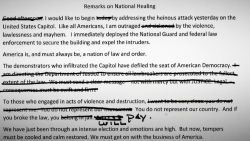Red states are building a nation within a nation
It was a revealing sign of the times when the Supreme Court last week, in response to a lawsuit from the Republican state attorneys general in Texas and Louisiana, blocked President Joe Biden’s administration from changing a key element of federal immigration policy.
The case was just the latest example of how red states, supported by Republican-appointed judges, are engaging in a multi-front offensive to seize control of national policy even while Democrats hold the White House and nominally control both the House and Senate. The red states are moving social policy sharply to the right within their borders on issues from abortion to LGBTQ rights and classroom censorship, while simultaneously working to hobble the ability of either the federal government or their own largest metro areas to set a different course.
To a degree unimaginable even a decade ago, this broad offensive increasingly looks like an effort to define a nation within a nation – one operating with a set of rules and policies that diverge from the rest of America more than in almost any previous era.
“The only time I can recall in American history even remotely like this [divergence] was after the Civil War when the separate but equal doctrine began to emerge” across the South as a backlash against the attempts of the 13th, 14th and 15th Constitutional amendments to ensure equality for the freed slaves, says Donald Kettl, the former dean of the public policy school at the University of Maryland and author of the book, “The Divided States of America.” He added, “It’s a multifront war with very sharp swords.”
The elements of the red state offensive include a flurry of lawsuits seeking to block actions from Biden’s administration on issues from the environment to civil rights to immigration; other lawsuits, such as the case around a Mississippi law that prompted the Supreme Court to overturn the right to abortion, aimed at providing states more leeway to deviate from previously nationally guaranteed rights; a flurry of red state laws that advance the cultural priorities of the GOP’s predominantly White Christian electoral base; and a steady flow of red state statutes blocking Democratic-leaning large cities and counties from setting their own policies on everything from police budgets to recycling.
The willingness of so many red states to adopt these common approaches testifies in part to the energetic organizing efforts of many conservative groups, from Heritage Action and the American Legislative Exchange Council to the Republican Attorneys General Association. But even more profoundly, the alignment of so many red states behind this shared agenda and strategy underscores how many of them are being shaped by a common set of economic and demographic trends.
On everything from gun ownership and religious affiliation to reliance on fossil fuels and participation (or not) in the 21st century information economy, most red states are following similar tracks, while diverging more sharply from the experience in blue states. Broadly speaking, blue states are more heavily exposed to the big demographic, cultural and economic forces reshaping American life, while red states are less exposed, and to the extent they are, those changes are centered overwhelmingly on their large metropolitan areas, which are trending Democratic and often – like in Austin or Atlanta – are a target for the Republicans controlling state government.
“It’s not at the level of Jim Crow, or certainly the difference between slave states and free states, but the differences are major,” says Jake Grumbach, a University of Washington political scientist who studies divergence among the states. And like Kettl, Grumbach believes the economic and political differences between the red and blue states are on track to only widen.
For Democrats, the red state offensive has been a source of rising alarm. The fact that the red states have succeeded in shifting policy toward the right on so many fronts has spurred widespread frustration within the party, as exemplified by California Gov. Gavin Newsom’s frequent calls for a more forceful response.
Yet the real threat in the red state effort to set their own course may be less an advantage for one side or another than a challenge to the nation’s underlying cohesion. As red states grow more aggressive about going their own way, while working to preempt challenges from above (the federal government) or below (blue local governments), they are testing how much divergence the nation’s fundamental cohesion can take before it begins to unravel.
“You have a very dangerous situation,” said David Leopold, a former president of the American Immigration Lawyers Association and legal adviser to the immigration advocacy group America’s Voice. “This is a direct threat to the nation as a unified entity. This is one step closer to the country dividing into two separate countries.”
Neither all red, nor all blue, states are carbon copies of each other. Significant differences remain within each bloc (and between urban and rural areas within each state).
One way to define the red states is to examine the 25 that voted for Donald Trump in both the 2016 and 2020 elections. At a time when the foreign-born share of the total US population is nearing its all-time high, 19 of the Trump states rank among the bottom 25 states in the share of their population composed of immigrants. While the overall share of college graduates is also rising, 20 of these states also rank in the bottom 25 for the share of their population that holds at least a four-year college degree, the Census Bureau found. The vast majority of Trump states, by contrast, fall into the top half when states are ranked by the share of their population that are White Christians or who own guns.
In their economic structure as well, the red states, as a group, are much more rooted in the powerhouse industries of the 20th century than their blue counterparts, and less represented in the information-age industries generating the greatest economic output in the 21st century. Of the states Trump won, 23 rank in the top 26 states that emit the most carbon from their energy sector for each dollar of economic output, according to the federal Energy Information Administration. As I’ve written before, that’s a revealing metric of the states that are most heavily integrated in the existing fossil fuel economy, either as producers or big consumers of coal, oil and natural gas.
By contrast, 18 of the Trump states rank in the bottom half for the share of the workforce employed in technology jobs, according to data provided to me by Brookings Metro, a center-left thinktank.
The red states have some clear economic strengths. Housing costs and taxes are generally lower in them, which has helped some of them add population at a rapid rate. But with these high-wage, high-value information-age jobs concentrating more in blue states, a substantial gap has opened between the two regions in economic output and wages. Only three smaller red states with large energy extraction industries (Alaska, North Dakota and Wyoming) have median wages that equal the average across all of the blue states, according to calculations by Grumbach and two co-authors in a chapter of the recent book, “The American Political Economy.”
Michael Podhorzer, chair of the Analyst Institute, a collaborative of progressive groups that studies elections, recently quantified the economic gap between the two sections in another way. He used a slightly different definition of red and blue states (based on both presidential voting and which party controls state government) whose main impact was to remove seven states into a third purple group: Trump-won North Carolina and six captured by Biden. Looking at the remaining states, Podhorzer calculated that the gross domestic product per person and the median household income are now both more than 25% greater in the blue section than in the red.
To a somewhat remarkable extent, the two major sections are divided as well in the basic structure of where people live – with the blue states revolving much more around big metropolitan centers. Using a classification system that divides communities into six categories from most to least urban, Podhorzer calculated that over three-fifths of residents in the blue states live in the two most dense categories (core urban counties and inner suburbs) while less than one-third live in the least urban categories. Red states are almost the mirror image: almost three-in-five residents live in the three least urban categories, while slightly less than one-in-three reside in the two most urban groupings.
Those population findings put an exclamation point on the underlying economic divergence. The most urban counties are the most Democratic-leaning parts of the red states – places like Houston, Dallas, Atlanta, Phoenix and their inner suburbs. Conversely, the least urban places are the most Republican-leaning parts of the blue states. If you subtract each of those outlying areas from their section’s total economic output – that is, remove the most urban places from the red total and the most rural places from the blue – the gap between them in total economic output widens even further: with those counties removed from each side, the blue section’s contribution to the total US gross national product is an astonishing 75% bigger than the red section’s.
To a far greater extent than in earlier generations, control of state government now aligns with states’ preferences in presidential elections. Republicans now control both chambers of the state legislature in all of the 25 states that voted two times for Trump except for Nebraska, which has a unicameral nonpartisan legislature. Republicans also control the governorship in 21 of the two-time Trump states, all but Louisiana, Kansas, Kentucky and North Carolina.
With this preponderant political control, Republicans in these states have been at the forefront of efforts to roll back what legal scholars have called the “rights revolution” of the past six decades in which the Supreme Court and Congress have nationalized a wide array of rights – from abortion to contraception and same-sex marriage – and constrained the ability of states to impinge on those rights.
Of the 25 states that voted for Trump, 19 have already moved to restrict abortion access since the Supreme Court last month struck down Roe v. Wade, according to the Guttmacher Institute, an abortion rights thinktank that tracks state policy. Four other two-time Trump states are considered likely to also restrict abortion in the coming months, with Indiana beginning a special session on Monday that could pass new limits and Kansas voters deciding next week on a constitutional amendment that could open the door to future restrictions. The only Trump states where abortion rights do not appear in imminent jeopardy are North Carolina (where Democratic Gov. Roy Cooper has vetoed anti-abortion legislation) and Alaska.
Similarly, 18 of the Trump states have passed laws preventing transgender girls from competing on girls’ school sports teams, with several also moving against parents who authorize gender-affirming care for their minor children. Most of these same states have passed laws since 2021 restricting how public school teachers can discuss issues of race, gender or sexual orientation, such as Florida’s “don’t say gay” bill. And several on the list have simultaneously passed laws making it easier for critics to ban books from school libraries. These states also dominate the list of jurisdictions that have passed legislation making it more difficult to vote in response to Trump’s false claims of fraud in the 2020 election.
“Right wing culture wars are now taking on even more significance because the Supreme Court has tossed what were once protected constitutional rights into the political battlefield,” Cooper, who chairs the Democratic Governors Association, told me in an interview. “A zip code should not determine a woman’s reproductive rights, but that’s where we are right now.”
As I’ve written, red states over the past decade have increasingly preempted the authority of blue-trending local governments across a dizzying array of issues – everything from environmental rules to police budgets to masking or lockdown rules issued in response to the Covid-19 pandemic. Conservative Republicans in the Texas state legislature have announced they intend to introduce legislation next year that would authorize district attorneys from any county to prosecute violations of the state’s abortion ban – a means of circumventing officials in large blue counties who have indicated they would not prioritize such enforcement.
Simultaneously red states are aggressively using the courts to either overturn national rights or to block action from the federal government across a wide array of issues. Sixteen of the Trump states filed briefs supporting Mississippi in the lawsuit that led to the Supreme Court majority overturning Roe v. Wade. Eighteen of these states have joined a lawsuit seeking to block the Biden administration’s regulations extending to transgender students the educational civil rights protections established under Title IX. The Biden administration’s efforts to combat climate change have been another frequent target of lawsuits from various combinations of the same red states.
The rulings constraining Biden on immigration may encapsulate most precisely how the alliance of red states and GOP-appointed judges are interacting to constrict federal action.
Various combinations of these states, usually led by Texas, have launched multiple federal lawsuits designed to prevent Biden from reversing hardline immigration policies set by Trump. That included the case in which the Supreme Court last week let stand a district court ruling from a Trump-appointed judge that is preventing the Biden administration from setting immigration enforcement priorities different from those Trump established. Last year, Andrew Hanen, a conservative district court judge appointed by George W. Bush, in response to a suit brought by nine red states, issued an injunction blocking the Biden administration from accepting new applications under the program that provides legal protection to young people brought to the US illegally by their parents.
Leopold, the former president of the American Immigration Lawyers Association, notes that these immigration cases have followed a similar trajectory. The red states, led by Texas, find a sympathetic district court judge, usually based in Texas, to target for the first hearing, which ensures that the case rises into the Fifth Circuit Court of Appeals, perhaps the country’s most conservative, and then from there reaches the Supreme Court, which is now dominated by six GOP-appointed justices. Leopold calls this the “anti-immigrant judicial pipeline” and says it has become a template for blocking federal action far beyond issues of migration.
“These are attacks on specific policy choices that have traditionally been assigned to the executive … that are preventing Biden from effectively doing his job,” Leopold said. “What they have done is with the Trump years behind them, and with a deeper [roster] on the bench, they have completely used this politicized [Supreme] Court to make federal policy and to thwart the specific policy objectives of the Biden administration. Forget that 81 million people voted for him, this is about using the court as a political tool. And they have perfected the strategy.”
Seen as a whole, the red states’ drive to set their own rules, while blocking any interference from either blue-leaning local governments or a Democratic-controlled federal government, represents the broadest effort to carve out a separate sphere of influence since the fierce resistance to reconstruction across the South after the Civil War that ultimately led to Jim Crow segregation, Kettl believes. In some respects, he argues, red states are displaying a greater separatist impulse today than the South did then.
“The late 19th century had a focus on separate but equal doctrine, and it had to do with a fundamental question of social policy,” Kettl told me. “This is an effort on a far broader collection of fronts – immigration, abortion, health care, the governance of schools, the issues of transportation policy. One after another. It’s on a far broader front than was ever the case in the late 19th century.”
For now, Kettl sees the initial red state Republican goal primarily as consolidating these new rules and blocking any interference – what he calls “an effort to build very high castle walls with a very deep moat.” But like Grumbach and other experts on state policy, Kettl is dubious that Republicans will settle for imposing their values solely on the states now under their control. As the red states pursue a more consistent and coordinated course, Kettl predicts that Republicans will “try to impose [this] policy on the nation as a whole” if they achieve the federal power to do so.
Blue states such as California, New York, Illinois and Colorado have moved forcefully over the past two years to expand many of the liberties now under siege in the red states. But congressional Republicans while in the minority have already introduced proposals that would apply the red state rules across the entire nation on many of these same issues. The new social order red states are now sketching behind their “castle” walls may offer the best preview of what Republicans will try to impose on all states the next time they achieve unified control of the White House and Congress in Washington.

















No comments:
Post a Comment